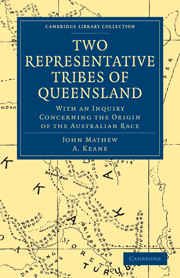 Two Representative Tribes of Queensland
Two Representative Tribes of Queensland Book contents
- Frontmatter
- Contents
- LIST OF ILLUSTRATIONS
- INTRODUCTION
- PREFACE
- CHAP. I INQUIRY CONCERNING THE ORIGIN OF THE AUSTRALIAN RACE
- CHAP. II THE COUNTRY OF THE KABI AND WAKKA TRIBES
- CHAP. III PHYSICAL AND MENTAL CHARACTERS
- CHAP. IV DAILY LIFE—SHELTER—FOOD—CLOTHING
- CHAP. V MAN-MAKING AND OTHER CEREMONIES
- CHAP. VI DISEASE AND TREATMENT—DEATH—BURIAL AND MOURNING
- CHAP. VII ART—IMPLEMENTS—UTENSILS—WEAPONS—CORROBOREES
- CHAP. VIII SOCIAL ORGANISATION
- CHAP. IX THE FAMILY—KINSHIP AND MARRIAGE
- CHAP. X RELIGION AND MAGIC
- CHAP. XI MYTHS AND LEGENDS
- CHAP. XII LANGUAGE
- VOCABULARY
CHAP. I - INQUIRY CONCERNING THE ORIGIN OF THE AUSTRALIAN RACE
Published online by Cambridge University Press: 29 August 2010
- Frontmatter
- Contents
- LIST OF ILLUSTRATIONS
- INTRODUCTION
- PREFACE
- CHAP. I INQUIRY CONCERNING THE ORIGIN OF THE AUSTRALIAN RACE
- CHAP. II THE COUNTRY OF THE KABI AND WAKKA TRIBES
- CHAP. III PHYSICAL AND MENTAL CHARACTERS
- CHAP. IV DAILY LIFE—SHELTER—FOOD—CLOTHING
- CHAP. V MAN-MAKING AND OTHER CEREMONIES
- CHAP. VI DISEASE AND TREATMENT—DEATH—BURIAL AND MOURNING
- CHAP. VII ART—IMPLEMENTS—UTENSILS—WEAPONS—CORROBOREES
- CHAP. VIII SOCIAL ORGANISATION
- CHAP. IX THE FAMILY—KINSHIP AND MARRIAGE
- CHAP. X RELIGION AND MAGIC
- CHAP. XI MYTHS AND LEGENDS
- CHAP. XII LANGUAGE
- VOCABULARY
Summary
A former work, Eaglehawk and Crow, dealt with the Australian aborigines as a whole. In it I discussed the larger questions of their origin and distribution, and made a survey of the languages which embraced an original classification. My work obtained, for the most part, as favourable a reception as I could have expected.
A difficulty I had to face was to find a term which might suitably include Papuans, Melanesians, autochthonous Australians and Tasmanians. Differences of nomenclature among previous writers embarrassed me, some using Papuan, others Melanesian, as the more comprehensive name. I adopted Papuan.
One primary aim I had in view was to make my work, as far as possible, an original contribution to the solution of Australian problems. This principle led me to restrict my borrowing of materials and accounts for the large space given to philological discussion. I am able to speak one Australian language, and had studied the whole field of Australian languages, and was therefore able to comment upon them and draw conclusions from them at first hand.
I have been blamed for attaching too much weight to linguistic evidence. I acknowledge that I might have placed less stress upon linguistic resemblances as proof of racial affinity. But it should be observed that, while fifty years ago or more, when Bopp and Max Müller were founding the science of comparative philology, the tendency was to lean too much upon language in ethnological research, the present tendency is to lean too little upon it.
- Type
- Chapter
- Information
- Two Representative Tribes of QueenslandWith an Inquiry Concerning the Origin of the Australian Race, pp. 25 - 66Publisher: Cambridge University PressPrint publication year: 2010First published in: 1910


